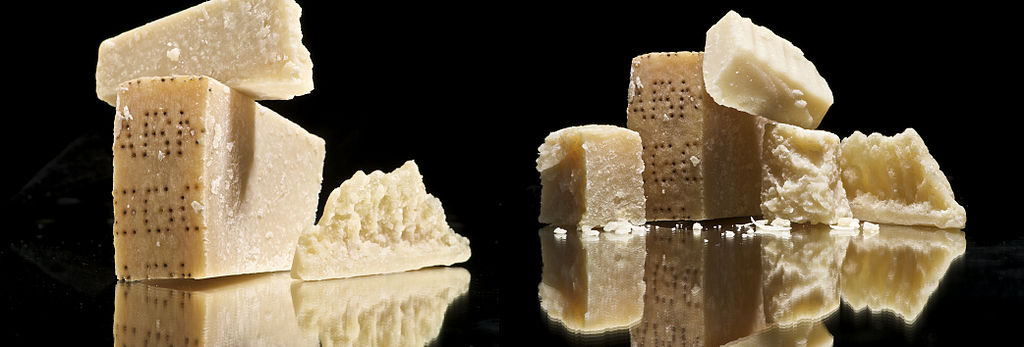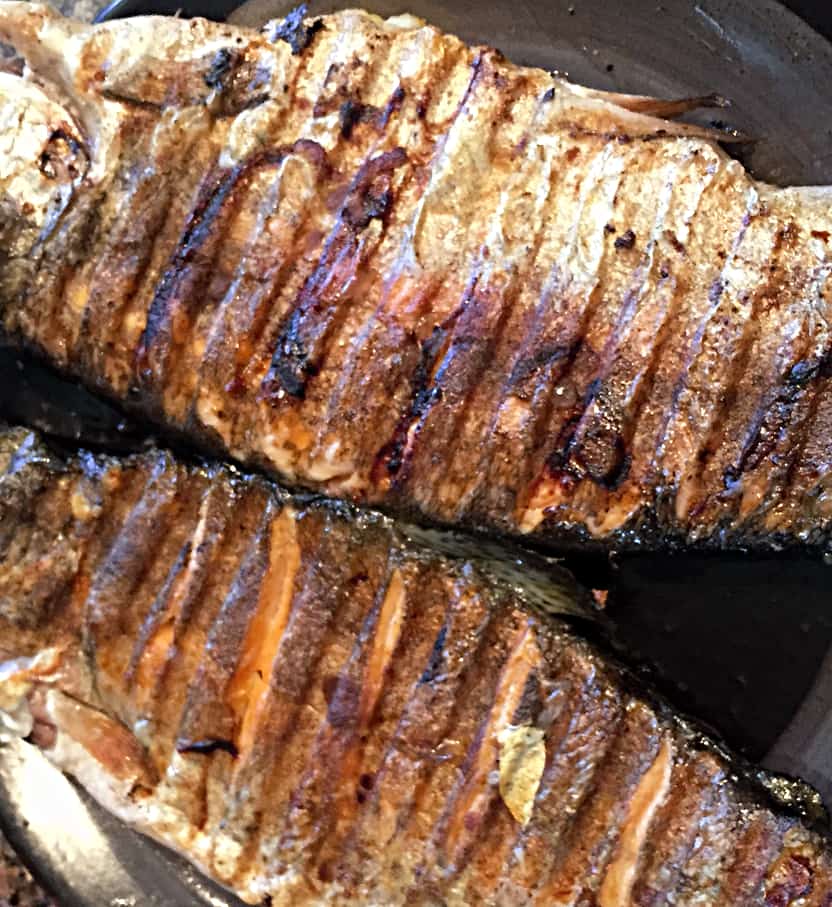Parmesan Cheese vs. Trout
Nutrition comparison of Parmesan Cheese and Cooked Trout
Ever wonder how your favorite foods stack up against each other in terms of nutrition?
We compared the nutritional contents of
parmesan cheese
versus
cooked
trout
(100g each)
below using 2020 USDA and NIH data[1].
For a quick recap of significant nutrients and differences in parmesan cheese and trout:
- Both parmesan cheese and trout are high in calories and protein.
- For omega-3 fatty acids, trout has more dha, epa and dpa than parmesan cheese.
- Parmesan cheese is an excellent source of Vitamin A and calcium.
- Trout has more thiamin, niacin, Vitamin B6 and Vitamin B12, however, parmesan cheese contains more riboflavin and pantothenic acid.
- Trout is an excellent source of potassium.
USDA sources for nutritional information: Parmesan Cheese (Cheese, parmesan, hard) and Trout (Trout, cooked, NS as to cooking method) . Have a correction or suggestions? Shoot us an email.
Calories and Carbs
calories
Both parmesan cheese and trout are high in calories. Parmesan cheese has 91% more calories than trout - parmesan cheese has 392 calories per 100 grams and trout has 205 calories.
| Parmesan Cheese | Trout | |
|---|---|---|
| Protein | 37% | 49% |
| Carbohydrates | 3% | ~ |
| Fat | 59% | 51% |
| Alcohol | ~ | ~ |
carbohydrates
Both parmesan cheese and trout are low in carbohydrates - parmesan cheese has 3.2g of total carbs per 100 grams and trout has 0.1g of carbohydrates.
sugar
Parmesan cheese and trout contain similar amounts of sugar - parmesan cheese has 0.11g of sugar per 100 grams and trout has 0.04g of sugar.
Protein
protein
Both parmesan cheese and trout are high in protein. Parmesan cheese has 47% more protein than trout - parmesan cheese has 35.8g of protein per 100 grams and trout has 24.4g of protein.
Fat
saturated fat
Parmesan cheese is high in saturated fat and trout has 85% less saturated fat than parmesan cheese - parmesan cheese has 14.9g of saturated fat per 100 grams and trout has 2.2g of saturated fat.
cholesterol
Parmesan cheese and trout contain similar amounts of cholesterol - parmesan cheese has 68mg of cholesterol per 100 grams and trout has 72mg of cholesterol.
Vitamins
Vitamin C
Trout has more Vitamin C than parmesan cheese - trout has 3.4mg of Vitamin C per 100 grams and parmesan cheese does not contain significant amounts.
Vitamin A
Parmesan cheese is an excellent source of Vitamin A and it has 138% more Vitamin A than trout - parmesan cheese has 207ug of Vitamin A per 100 grams and trout has 87ug of Vitamin A.
Vitamin D
Parmesan cheese has more Vitamin D than trout - parmesan cheese has 19iu of Vitamin D per 100 grams and trout does not contain significant amounts.
Vitamin E
Trout has 14 times more Vitamin E than parmesan cheese - parmesan cheese has 0.22mg of Vitamin E per 100 grams and trout has 3.3mg of Vitamin E.
Vitamin K
Parmesan cheese and trout contain similar amounts of Vitamin K - parmesan cheese has 1.7ug of Vitamin K per 100 grams and trout has 4.5ug of Vitamin K.
The B Vitamins
Trout has more thiamin, niacin, Vitamin B6 and Vitamin B12, however, parmesan cheese contains more riboflavin and pantothenic acid. Both parmesan cheese and trout contain significant amounts of folate.
| Parmesan Cheese | Trout | |
|---|---|---|
| Thiamin | 0.039 MG | 0.14 MG |
| Riboflavin | 0.332 MG | 0.11 MG |
| Niacin | 0.271 MG | 6.811 MG |
| Pantothenic acid | 0.453 MG | ~ |
| Vitamin B6 | 0.091 MG | 0.375 MG |
| Folate | 7 UG | 12 UG |
| Vitamin B12 | 1.2 UG | 4.47 UG |
Minerals
calcium
Parmesan cheese is an excellent source of calcium and it has 37 times more calcium than trout - parmesan cheese has 1184mg of calcium per 100 grams and trout has 31mg of calcium.
iron
Parmesan cheese has 110% more iron than trout - parmesan cheese has 0.82mg of iron per 100 grams and trout has 0.39mg of iron.
potassium
Trout is an excellent source of potassium and it has 403% more potassium than parmesan cheese - parmesan cheese has 92mg of potassium per 100 grams and trout has 463mg of potassium.
Omega-3 and Omega-6
omega 3s
For omega-3 fatty acids, trout has more DHA, EPA and DPA than parmesan cheese per 100 grams. Both parmesan cheese and trout contain significant amounts of alpha linoleic acid (ALA).
| Parmesan Cheese | Trout | |
|---|---|---|
| alpha linoleic acid | 0.297 G | 0.268 G |
| DHA | ~ | 0.631 G |
| EPA | ~ | 0.265 G |
| DPA | ~ | 0.111 G |
| Total | 0.297 G | 1.275 G |
omega 6s
Comparing omega-6 fatty acids, trout has more linoleic acid than parmesan cheese per 100 grams.
| Parmesan Cheese | Trout | |
|---|---|---|
| linoleic acid | 0.272 G | 1.929 G |
| other omega 6 | ~ | 0.053 G |
| Total | 0.272 G | 1.982 G |
Customize your serving size
The comparison below is by common portions, e.g. cups, packages. You can also see a more concrete comparison by weight at equal weight (by grams) comparison.
Note: The specific food items compared are: Parmesan Cheese (Cheese, parmesan, hard) and Trout (Trout, cooked, NS as to cooking method) .
Parmesan Cheese g
()
|
Daily Values (%) |
Cooked Trout g
()
|
|||||
|---|---|---|---|---|---|---|---|
| KCAL % |
|
5% | calories | 5% |
|
KCAL % | |
| G % |
|
5% | carbohydrates | 5% |
|
G % | |
| G % |
|
5% | dietary fiber | 5% |
|
G % | |
| G | 5% | sugar | 5% | G | |||
| G % |
|
5% | total fat | 5% |
|
G % | |
| G % |
|
5% | saturated fat | 5% |
|
G % | |
| G | 5% | monounsaturated fat | 5% | G | |||
| G | 5% | polyunsaturated fat | 5% | G | |||
| G | 5% | trans fat | 5% | G | |||
| MG | 5% | cholesterol | 5% | MG | |||
| MG % |
|
5% | sodium | 5% |
|
MG % | |
| 5% | Vitamins and Minerals | 5% | |||||
| UG % |
|
5% | Vitamin A | 5% |
|
UG % | |
| MG % |
|
5% | Vitamin C | 5% |
|
MG % | |
| IU % |
|
5% | Vitamin D | 5% |
|
IU % | |
| MG % |
|
5% | calcium | 5% |
|
MG % | |
| MG % |
|
5% | iron | 5% |
|
MG % | |
| MG % |
|
5% | magnesium | 5% |
|
MG % | |
| MG % |
|
5% | potassium | 5% |
|
MG % | |
| MG % |
|
5% | thiamin (Vit B1) | 5% |
|
MG % | |
| MG % |
|
5% | riboflavin (Vit B2) | 5% |
|
MG % | |
| MG % |
|
5% | niacin (Vit B3) | 5% |
|
MG % | |
| MG % |
|
5% | Vitamin B6 | 5% |
|
MG % | |
| MG % |
|
5% | pantothenic acid (Vit B5) | 5% |
|
MG % | |
| UG % |
|
5% | folate (Vit B9) | 5% |
|
UG % | |
| UG % |
|
5% | Vitamin B12 | 5% |
|
UG % | |
| MG % |
|
5% | Vitamin E | 5% |
|
MG % | |
| UG % |
|
5% | Vitamin K | 5% |
|
UG % | |
| G % |
|
5% | protein | 5% |
|
G % | |
| UG % |
|
5% | biotin (Vit B7) | 5% |
|
UG % | |
| MG % |
|
5% | choline | 5% |
|
MG % | |
| MG % |
|
5% | chlorine | 5% |
|
MG % | |
| UG % |
|
5% | chromium | 5% |
|
UG % | |
| MG % |
|
5% | copper | 5% |
|
MG % | |
| UG % |
|
5% | fluoride | 5% |
|
UG % | |
| UG % |
|
5% | iodine | 5% |
|
UG % | |
| MG % |
|
5% | manganese | 5% |
|
MG % | |
| UG % |
|
5% | molybdenum | 5% |
|
UG % | |
| MG % |
|
5% | phosphorus | 5% |
|
MG % | |
| UG % |
|
5% | selenium | 5% |
|
UG % | |
| MG % |
|
5% | zinc | 5% |
|
MG % | |
| G | 5% | Water | 5% | G | |||
| G | 5% | Starch | 5% | G | |||
| G | 5% | Alcohol | 5% | G | |||
FAQ
Does parmesan cheese or trout contain more calories in 100 grams?Both parmesan cheese and trout are high in calories. Parmesan cheese has 90% more calories than trout - parmesan cheese has 392 calories in 100g and trout has 205 calories.
Is parmesan cheese or trout better for protein?
Both parmesan cheese and trout are high in protein. Parmesan cheese has 50% more protein than trout - parmesan cheese has 35.8g of protein per 100 grams and trout has 24.4g of protein.
Does parmesan cheese or trout contain more calcium?
Parmesan cheese is a rich source of calcium and it has 37 times more calcium than trout - parmesan cheese has 1184mg of calcium in 100 grams and trout has 31mg of calcium.
Does parmesan cheese or trout contain more potassium?
Trout is a rich source of potassium and it has 400% more potassium than parmesan cheese - parmesan cheese has 92mg of potassium in 100 grams and trout has 463mg of potassium.

